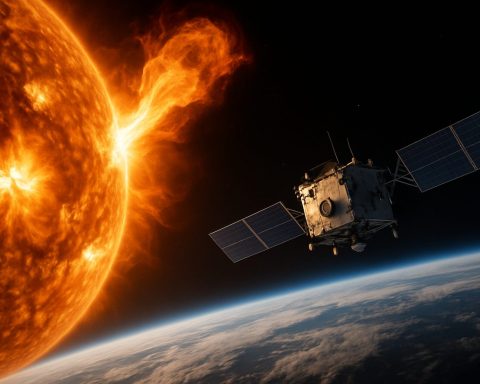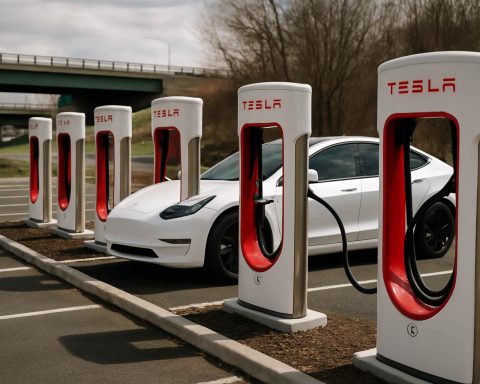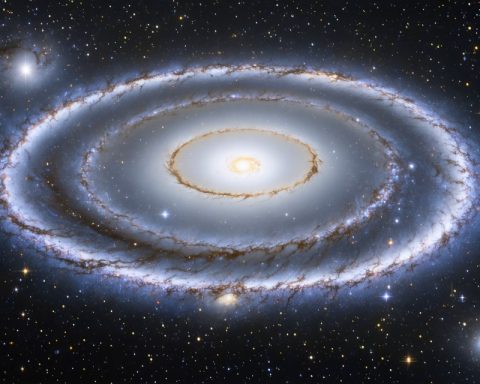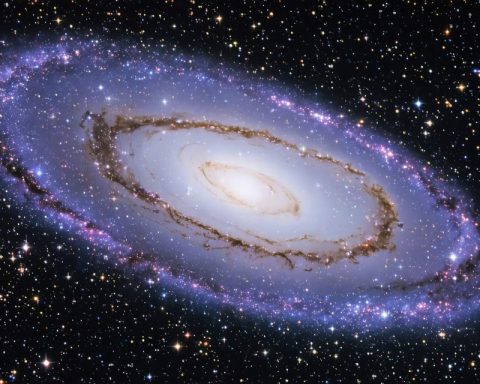Solar Tempests & Orbital Guardians: Inside the High-Stakes Realm of Space-Weather Satellite Defense
- Market Overview: The Expanding Role of Space-Weather Satellites
- Technology Trends: Innovations Shaping Space-Weather Monitoring
- Competitive Landscape: Key Players and Strategic Moves
- Growth Forecasts: Projections for the Space-Weather Satellite Sector
- Regional Analysis: Global Hotspots and Emerging Markets
- Future Outlook: Evolving Missions and Next-Gen Capabilities
- Challenges & Opportunities: Navigating Risks and Unlocking Potential
- Sources & References
“Artificial intelligence – especially generative AI – continued its explosive growth in June and July 2025, marked by headline-grabbing news, scientific breakthroughs, industry moves, market forecasts, new regulations, and debates on societal impact.” (source)
Market Overview: The Expanding Role of Space-Weather Satellites
Space-weather satellites have become indispensable guardians of modern infrastructure, silently monitoring the Sun’s volatile activity and its impact on Earth. As solar tempests—such as solar flares and coronal mass ejections (CMEs)—grow in frequency and intensity during the current solar cycle, the demand for advanced space-weather monitoring has surged. These satellites provide real-time data that protect power grids, aviation, satellite communications, and even astronauts from the potentially devastating effects of space weather.
Solar storms can unleash geomagnetic disturbances capable of disrupting GPS navigation, radio communications, and electrical grids. For instance, the infamous 1989 Quebec blackout was triggered by a geomagnetic storm, leaving millions without power (NASA). Today, with the proliferation of satellites and the growing reliance on space-based technologies, the stakes are even higher.
To address these risks, a constellation of space-weather satellites—often referred to as “orbital guardians”—has been deployed. Key missions include:
- NOAA’s GOES-R Series: These geostationary satellites provide continuous monitoring of solar X-rays, energetic particles, and magnetic fields, enabling early warnings for solar storms (NOAA GOES-R).
- NASA’s Solar Dynamics Observatory (SDO): Launched in 2010, SDO delivers high-resolution imagery of the Sun, helping scientists track solar activity and predict space-weather events (NASA SDO).
- ESA’s Solar Orbiter: This European mission, launched in 2020, is providing unprecedented close-up observations of the Sun’s poles and magnetic environment (ESA Solar Orbiter).
The global space-weather monitoring market is projected to grow at a CAGR of 8.2% from 2023 to 2030, driven by increased investment from governments and private sector players (MarketsandMarkets). The U.S., Europe, and China are leading the charge, with new missions and public-private partnerships emerging to bolster resilience against solar threats.
As solar activity intensifies, the “secret life” of space-weather satellites is coming into sharper focus. These orbital guardians are not only scientific sentinels but also critical assets for safeguarding the digital backbone of the 21st century.
Technology Trends: Innovations Shaping Space-Weather Monitoring
Space-weather satellites play a pivotal role in monitoring and mitigating the effects of solar tempests—powerful eruptions from the Sun that can disrupt communications, navigation systems, and even power grids on Earth. As solar activity intensifies during the current solar cycle, technological innovations are transforming how these “orbital guardians” detect, analyze, and forecast space weather events.
- Advanced Sensor Arrays: Modern satellites are equipped with sophisticated instruments capable of measuring solar wind, magnetic fields, and high-energy particles. For example, NASA’s Solar Dynamics Observatory (SDO) and the European Space Agency’s Solar Orbiter provide high-resolution imagery and real-time data, enabling scientists to track solar flares and coronal mass ejections (CMEs) with unprecedented accuracy.
- Constellation Deployments: Instead of relying on single satellites, agencies are launching constellations for continuous, multi-point monitoring. The NOAA’s GOES-R series and the upcoming NASA SWARM mission exemplify this trend, providing overlapping coverage and redundancy to ensure uninterrupted data streams.
- Artificial Intelligence & Automation: AI-driven algorithms are now embedded in satellite systems to autonomously detect anomalies and predict space-weather events. These tools can process vast datasets in real time, reducing response times for issuing alerts. The NASA AI for Solar Storm Prediction project demonstrates how machine learning is revolutionizing forecasting accuracy.
- Miniaturization & Cost Reduction: The rise of CubeSats and small satellites has democratized space-weather monitoring. Projects like the NASA CubeSat Launch Initiative allow universities and startups to deploy affordable sensors, expanding the global observation network.
- International Collaboration: Space-weather monitoring is increasingly a global effort. Initiatives such as the International Space Environment Service (ISES) facilitate data sharing and joint research, enhancing preparedness for geomagnetic storms worldwide.
As solar tempests grow in frequency and intensity, the secret life of space-weather satellites is more vital than ever. These technological advancements ensure that Earth’s orbital guardians remain vigilant, safeguarding our planet’s infrastructure and daily life from the unpredictable fury of the Sun.
Competitive Landscape: Key Players and Strategic Moves
The competitive landscape for space-weather satellites—often dubbed “Solar Tempests & Orbital Guardians”—is rapidly evolving as both governmental and private entities recognize the critical importance of monitoring solar activity and its effects on Earth’s technological infrastructure. The market is dominated by a handful of established players, but new entrants and international collaborations are reshaping the field.
- NASA and NOAA (United States): The United States leads with flagship missions such as the GOES-R Series and the Solar Dynamics Observatory (SDO). The DSCOVR satellite, jointly operated by NOAA and NASA, provides real-time solar wind data crucial for space weather forecasting.
- ESA (European Space Agency): ESA’s Space Weather Office and missions like Solar Orbiter (launched in 2020) are central to Europe’s efforts, offering high-resolution imaging and in-situ measurements of the Sun’s heliosphere.
- China: China is rapidly expanding its capabilities, with the Advanced Space-based Solar Observatory (ASO-S) launched in 2022, marking a significant step in independent solar monitoring and research.
- Private Sector: Companies like Spire Global and Planet Labs are leveraging small satellite constellations to provide commercial space weather data, targeting industries such as aviation, telecommunications, and energy.
Strategic moves in the sector include increased international collaboration, such as the ESA-NASA partnership on space weather monitoring, and the development of next-generation satellites with enhanced predictive capabilities. The NOAA Space Weather Next program aims to replace aging assets and improve forecasting accuracy, while private firms are innovating with AI-driven analytics and rapid deployment of CubeSats.
As the threat of solar storms to power grids, satellites, and navigation systems grows, the race to deploy advanced “orbital guardians” is intensifying, with the global space weather monitoring market projected to reach $1.5 billion by 2028.
Growth Forecasts: Projections for the Space-Weather Satellite Sector
The increasing frequency and intensity of solar tempests—powerful eruptions of energy from the Sun—have elevated the importance of space-weather satellites, often dubbed “orbital guardians.” These specialized satellites monitor solar activity, providing early warnings of geomagnetic storms that can disrupt power grids, satellite communications, and navigation systems on Earth. As the world becomes more reliant on space-based infrastructure, the demand for advanced space-weather monitoring is projected to surge.
According to a recent report by MarketsandMarkets, the global space situational awareness (SSA) market, which includes space-weather satellites, is expected to grow from $1.5 billion in 2023 to $1.8 billion by 2028, at a CAGR of 3.7%. This growth is driven by heightened awareness of space-weather risks and increased investments from both government agencies and private sector players.
Key drivers include:
- Solar Cycle 25: The current solar cycle, which began in 2019, is forecasted to peak between 2024 and 2025, with a higher-than-average number of solar storms (NOAA SWPC). This has prompted agencies like NASA and ESA to accelerate the deployment of new monitoring satellites.
- Critical Infrastructure Protection: The vulnerability of power grids and communication networks to solar storms has led to increased funding for space-weather forecasting missions, such as NASA’s upcoming Geospace Dynamics Constellation (NASA GDC).
- Commercial Satellite Boom: The proliferation of commercial satellites in low Earth orbit (LEO) has heightened the need for real-time space-weather data to protect assets and ensure operational continuity (SpaceNews).
Looking ahead, the sector is expected to see further innovation, with miniaturized sensors, AI-driven forecasting, and international data-sharing initiatives enhancing the capabilities of these “orbital guardians.” As solar activity intensifies and the stakes for space-based infrastructure rise, the space-weather satellite sector is poised for robust growth, playing a pivotal role in safeguarding both terrestrial and orbital assets.
Regional Analysis: Global Hotspots and Emerging Markets
Space-weather satellites play a pivotal role in monitoring and mitigating the effects of solar tempests—intense bursts of solar activity that can disrupt terrestrial and orbital infrastructure. As global reliance on satellite communications, navigation, and power grids intensifies, the demand for advanced space-weather monitoring has surged, creating regional hotspots and fostering emerging markets in this specialized sector.
Global Hotspots
- United States: The U.S. remains a leader in space-weather satellite deployment, with agencies like NOAA operating the GOES and DSCOVR satellites. The 2024 budget allocates over $2.3 billion for NOAA’s satellite programs, reflecting the nation’s commitment to space-weather resilience (NOAA).
- European Union: The EU’s ESA is advancing the Lagrange mission, set to launch in 2027, to provide real-time solar monitoring from the L5 Lagrange point. The EU’s Copernicus program also integrates space-weather data for critical infrastructure protection (Copernicus).
- China: China’s FY-3E and SWAS satellites are part of a growing constellation aimed at enhancing the nation’s space-weather forecasting and early warning capabilities.
Emerging Markets
- India: The Indian Space Research Organisation (ISRO) is developing the Aditya-L1 mission, scheduled for launch in 2024, to study the Sun’s corona and improve regional space-weather forecasting.
- Japan: Japan’s ERG (Arase) satellite, launched in 2016, continues to provide valuable data on geomagnetic storms and radiation belts, supporting Asia-Pacific resilience.
- Private Sector: Companies like Spire Global and Planet Labs are entering the market, offering commercial space-weather data services and expanding access beyond government agencies.
As solar activity intensifies in the current solar cycle, investment in space-weather satellites is expected to grow, with regional leaders and emerging players alike recognizing their strategic importance for economic and security interests worldwide.
Future Outlook: Evolving Missions and Next-Gen Capabilities
Space-weather satellites are entering a new era as solar activity intensifies and the world’s reliance on space-based infrastructure grows. The next solar maximum, expected between 2024 and 2026, is forecast to be one of the most active in decades, increasing the risk of geomagnetic storms that can disrupt power grids, navigation, and communications (NOAA SWPC). This heightened threat is driving innovation in both the missions and technologies of space-weather satellites, positioning them as critical “orbital guardians” for modern society.
- Advanced Sensing and Early Warning: Next-generation satellites, such as NASA’s upcoming PACE and ESA’s Lagrange mission, will deploy advanced sensors to monitor solar flares, coronal mass ejections (CMEs), and energetic particles in real time. These platforms will provide earlier and more accurate warnings, enabling better protection for satellites, astronauts, and terrestrial infrastructure.
- Constellation Deployments: The trend is shifting from single-point observatories to distributed constellations. For example, the TRACERS mission will use twin satellites to study the interaction between the solar wind and Earth’s magnetosphere, offering a more comprehensive view of space weather dynamics.
- AI and Data Fusion: Artificial intelligence is being integrated to process the massive data streams from multiple satellites, improving the speed and accuracy of space-weather forecasting (NASA AI for Space Weather).
- International Collaboration: Recognizing the global impact of solar storms, agencies are increasing data sharing and joint missions. The NOAA SWFO-L1 mission, set for launch in 2025, will work in tandem with European and Japanese satellites to provide continuous, multi-point monitoring of the Sun-Earth system.
As solar tempests become more frequent and severe, the “secret life” of space-weather satellites is coming into the spotlight. Their evolving missions and next-gen capabilities are not only safeguarding critical infrastructure but also enabling new scientific discoveries about the Sun-Earth connection. The future will see these orbital guardians play an ever more vital role in protecting our technological civilization from the unpredictable fury of the Sun.
Challenges & Opportunities: Navigating Risks and Unlocking Potential
Space weather—primarily driven by solar activity such as flares and coronal mass ejections—poses significant risks to satellites, power grids, aviation, and communications infrastructure. The increasing reliance on satellite technology for navigation, communication, and Earth observation has amplified the need for robust space-weather monitoring and forecasting systems. This has given rise to a new generation of “orbital guardians”: specialized satellites designed to detect, analyze, and relay real-time data on solar tempests.
-
Challenges:
- Detection and Prediction: Solar storms can disrupt satellite electronics, degrade GPS accuracy, and even cause satellite drag due to atmospheric expansion. However, predicting the timing, intensity, and impact of these events remains complex. Current models, while improving, still struggle with precise forecasting (NASA).
- Satellite Vulnerability: The proliferation of satellites in low Earth orbit (LEO) increases the risk of cascading failures during severe space-weather events. The 2022 geomagnetic storm, for example, caused SpaceX to lose up to 40 Starlink satellites shortly after launch (Space.com).
- Data Gaps: Many existing space-weather satellites are aging, and there are concerns about potential data gaps if replacements are not launched in time. The U.S. National Oceanic and Atmospheric Administration (NOAA) has warned of possible lapses in critical space-weather monitoring (NOAA).
-
Opportunities:
- Next-Generation Satellites: New missions such as NASA’s PUNCH and ESA’s Vigil are set to enhance real-time monitoring and early warning capabilities, leveraging advanced imaging and AI-driven analytics (ESA).
- Commercial Collaboration: Private sector involvement is growing, with companies like Spire Global and SpaceX integrating space-weather sensors into their satellite constellations, creating new data streams and business models (Spire).
- Global Coordination: International initiatives, such as the World Meteorological Organization’s Space Weather Coordination Group, are fostering data sharing and joint response strategies, improving resilience across borders (WMO).
As solar activity intensifies in the current solar cycle, the role of space-weather satellites as “orbital guardians” is more critical than ever—presenting both formidable challenges and lucrative opportunities for innovation and collaboration.
Sources & References
- Solar Tempests & Orbital Guardians: The Secret Life of Space-Weather Satellites
- NASA
- NOAA GOES-R
- NASA SDO
- ESA
- MarketsandMarkets
- NOAA SWPC
- DSCOVR
- SWAS
- Planet Labs
- SpaceNews
- Copernicus
- FY-3E
- Aditya-L1
- ERG (Arase)
- Space.com
- WMO













